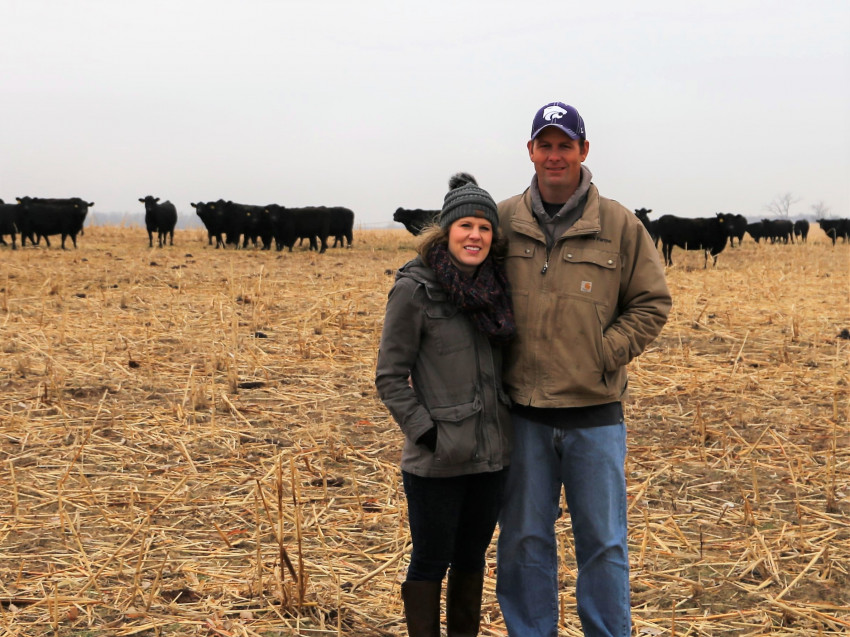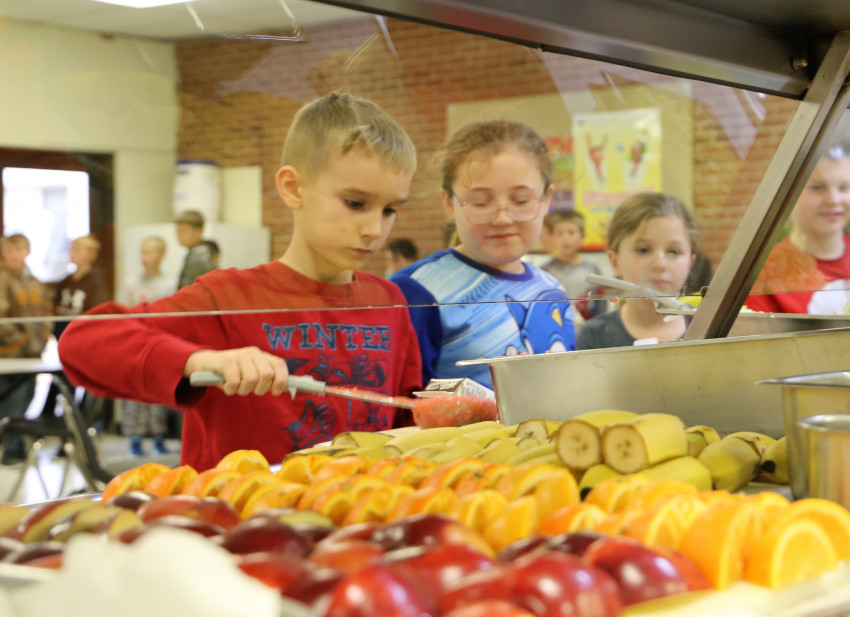By Greg Doering on May 6, 2020
Farmers Provide Donations for School Lunches
Donations from Stafford County farmers are feeding students at St. John-Hudson

EDITOR'S NOTE: Since the COVID-19 situation closed school buildings across Kansas and America, farmers and ranchers are becoming more creative about their marketing. Some are offering direct sales to consumers. To learn more about opportunities in Kansas, please visit www.fromthelandofkansas.com.
St. John is a typical community in central Kansas, described on the city’s website as a “beautiful, rural, residential city.” It’s surrounded by crops and cattle and full of community spirit. Nearly halfway between Great Bend and Pratt on Kansas Highway 281, signs outside town list the state championships of St. John-Hudson High School for travelers from both north and south.
It’s the first inkling of the pride that area residents have in their school system. It’s the kind of place where the social calendar revolves around Friday nights cheering on the hometown Tigers. And like most places in Kansas, it’s a town where parents want the best for their children.
That’s not to say there aren’t challenges like population loss and a struggling agricultural economy to deal with, but the city and sprawling 308-square-mile school district can count on the steadfast support of those who remain, like Stafford County farmers and ranchers Tyler and Leah Alpers.
After reading a story about farmers and ranchers in Ashland providing beef to students at the high school, the Alpers thought their local school district would benefit from a similar program.
“We were trying to think, ‘How many people can we come up with who would be willing to contribute?’” Leah says. “We just started writing names down and we felt like we’d have enough people.”
The Alpers started the Farm to School Program, which now sources donations from local producers for ground beef, hamburger patties and flour to feed the 350 K-12 students at St. John-Hudson.
The Alpers serve as coordinators for the program, lining up donations from others in the community. It might be a cow, flour from Stafford County Flour Mill or cash from local businesses to cover the processing costs at nearby Ellinwood Packing Plant.
“Once we got it going, it’s just communicating with the processor and scheduling dates,” Tyler says of the work required to keep the program running. “I do a reminder phone call with the individuals who are donating — give them a couple weeks’ notice. We send out a letter annually with the schedule. Everyone has plenty of advance notice.”
Josh Meyer, USD 350 superintendent, says all the donations go through the district’s education foundation, which gives donors a potential tax benefit, but the real reason the program has been so successful is Tyler and Leah.
“Tyler and Leah have connections in the community, and they’re doing this to help our bottom line and help the kids,” Meyer says.
LUNCH LOGISTICS
Leah says one of the initial questions that had to be answered was if the school could accept donated beef. All food served in the lunchroom has to meet federal guidelines. For the beef donations, the processing plant needs certification from the United States Department of Agriculture (USDA), and an inspector must be present when the animal is delivered for processing.
Leah also says there was a concern the program might require more labor from the food service staff to prepare meals. A partial solution was to have the processor make hamburger patties to save some time for the cooks.
“It costs more, but if it saves the staff time when they’re willing to take the time to cook the hamburgers, it’s well worth it, I think,” Tyler says.
“When we have hamburgers, they do take quite a bit of time to prepare because we cook them from a raw state,” food service director Sondra Davis says. “Before, we were using a precooked hamburger.”
Davis says it takes about 2½ hours to cook 300 burgers made from 90 percent lean meat. She says the St. John-Hudson school district is fortunate it already had two braising pans to fry the hamburgers. Some larger schools have explored implementing a similar program, but the time and equipment needed would make it cost prohibitive. For Davis though, the extra effort is worth it.
“I think the kids enjoy them more, so we’re willing to do the work,” she says. “All of this beef is raised in Stafford County. We’re pretty proud that our county is able to provide beef for our school.”
BEYOND BEEF
In addition to using five to six donated cows for the Farm to School Program, Davis and her crew of three staffers also use flour from the Stafford County Flour Mill in Hudson to bake fresh rolls and French bread. Davis says they use two types — regular white household flour and a blend of 60 percent whole-wheat and white flour — in the kitchen. Other producers offer up fresh melons when they’re in season.
“I think people in the community enjoy knowing their kids are being fed from products within our county,” Davis says.
BOTTOM-LINE BOOST
All the donations have added up to a substantial sum and have reduced the district’s food spending by about $10,000 per year.
“We were running a deficit of about $20,000 in our food service program and that was cut down to $7,000 in the first year,” Meyer says. “A lot of that was due to having the beef donated.”
Meyer says the savings equals about 12.5 percent of the budget for food service staff, and the program has other benefits.
“Anytime we can get locally sourced products, that’s a positive,” Meyer says.
The program also offers another chance for community members to feel like they are part of the success at St. John Hudson.
“People have strong roots,” Meyer says. “They want great things for their community.”
SIGNING UP DONORS
The Alpers made an initial list of patrons they thought would be willing to donate and started there. Once the word got out, though, there’s been no shortage of volunteers.
“Everyone I’ve talked to has been more than willing to donate and interested in helping the school, helping the kids, and providing the kids a better-quality product,” Tyler says. “Everyone who’s donated to the program has stuck with it. I think everyone sees the value of it.”
Leah says the beef donations work on a rotational basis, so people aren’t donating an animal every year.
“It’s every two or three years,” she says.
In addition to the tax deduction, donors also receive recognition in the form of a certificate on the wall in the cafeteria and a meal of their own.
“We do an appreciation dinner for our donors once a year,” Tyler says. “We’ve been hosting it at our house just kind of as a thank you.”
The program provides other ways for the community to get involved, like making donations to cover processing and packing costs.
“We were excited to get some other individuals or businesses involved in that way,” Tyler says.
Students are even finding ways to contribute.
“The school has been having an art auction over Memorial Day weekend— there are a lot of class reunions that weekend — and kids in the school make art that’s sold at the auction,” Tyler says. “Some of the proceeds support the Farm to School Program.”
ROOM TO GROW
Davis says she’s willing to accept more donations to “expand (the program) as much as we possibly can.” And Meyer has identified another area he hopes the district can address as the program continues to evolve.
“One thing we need to do a better job of is connecting it to the classroom,” he says. “Kids are aware of where the beef comes from, but we’re not really making that connection — the farm to the tables in our cafeteria.”
SPARKING A TREND
The Alpers got the idea for their Farm to School Program after reading a 2016 Kansas Living article about the USD 220 Beef Program that supports Ashland High School in Clark County.
“That piqued our interest and started a line of communication with our school district,” Tyler says.
Last fall, Tyler and Leah sat down with their own newspaper for an interview to tell the story about their Farm to School Program, which sparked the interest of civic-minded folks across the state.
“We’ve had several other school districts ask us about implementing similar programs,” Tyler says. “We’ve been more than willing to share our information, just as Ashland was more than willing to share with us. It’s nice to see the interest is there in other communities to do similar programs.”
Tyler says most of the questions deal with the logistics of finding a USDA-inspected packing plant. Another beef-to-schools program was launched in Barber County in December. There, the county Cattleman’s Association and Farm Bureau have both committed to helping with the processing fees of cattle taken to the Kiowa Locker. The meat will go to students at USD 245 and USD 255 schools.
All the programs must meet the criteria set forth in the federal Richard B. Russell School Lunch Act. Schools can accept agricultural products that retain their inherent character such as fresh fruits and vegetables. Other products, like ground beef, eggs and milk, have to come from licensed facilities.
The USDA also provides a planning guide for building a farm to school program with tips on how to create a team, buy local foods and plan menus, found at fns.usda.gov/cfs/farm-school-resources.






